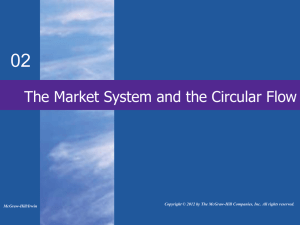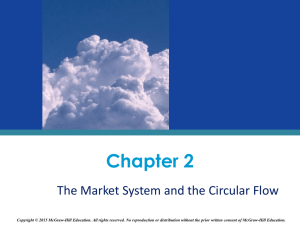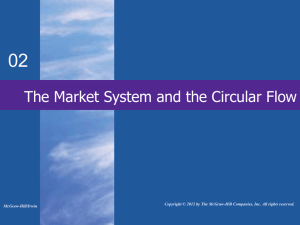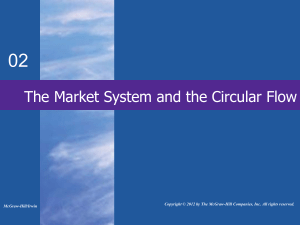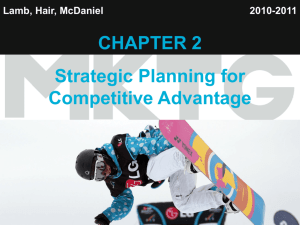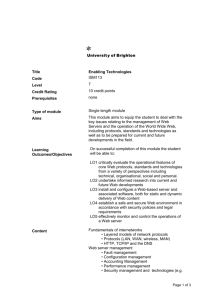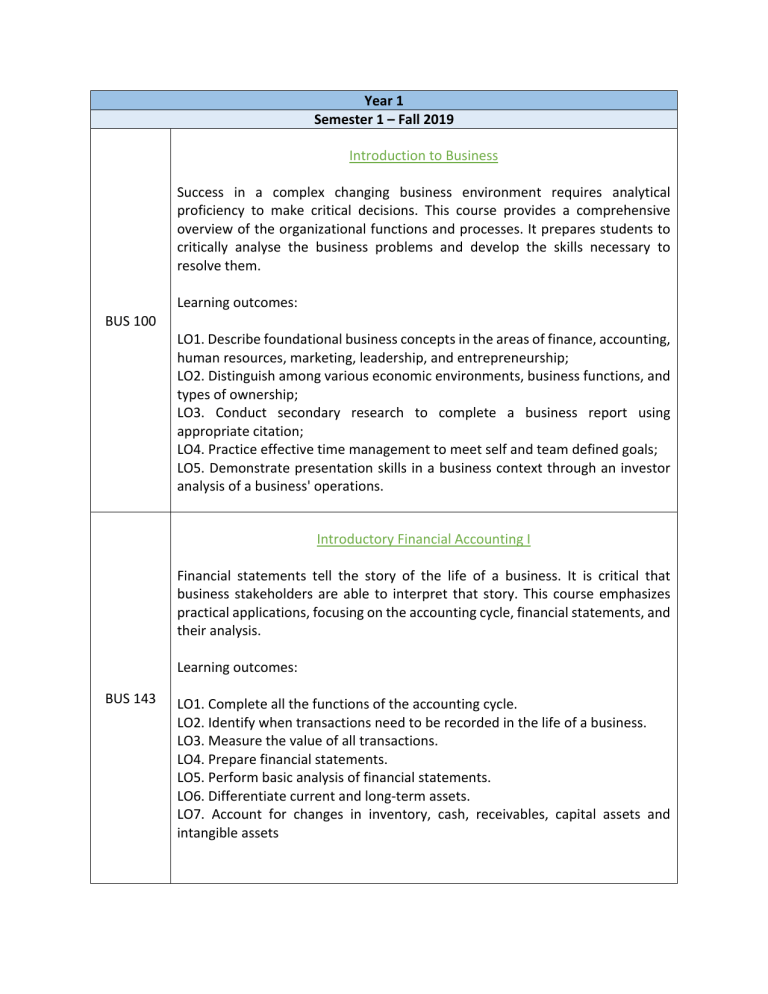
Year 1 Semester 1 – Fall 2019 Introduction to Business Success in a complex changing business environment requires analytical proficiency to make critical decisions. This course provides a comprehensive overview of the organizational functions and processes. It prepares students to critically analyse the business problems and develop the skills necessary to resolve them. BUS 100 Learning outcomes: LO1. Describe foundational business concepts in the areas of finance, accounting, human resources, marketing, leadership, and entrepreneurship; LO2. Distinguish among various economic environments, business functions, and types of ownership; LO3. Conduct secondary research to complete a business report using appropriate citation; LO4. Practice effective time management to meet self and team defined goals; LO5. Demonstrate presentation skills in a business context through an investor analysis of a business' operations. Introductory Financial Accounting I Financial statements tell the story of the life of a business. It is critical that business stakeholders are able to interpret that story. This course emphasizes practical applications, focusing on the accounting cycle, financial statements, and their analysis. Learning outcomes: BUS 143 LO1. Complete all the functions of the accounting cycle. LO2. Identify when transactions need to be recorded in the life of a business. LO3. Measure the value of all transactions. LO4. Prepare financial statements. LO5. Perform basic analysis of financial statements. LO6. Differentiate current and long-term assets. LO7. Account for changes in inventory, cash, receivables, capital assets and intangible assets Computerized Business Applications and MIS This course covers skill development, understanding, and application at an advanced level of word-processing, spreadsheets, presentation software, and databases integrated with an introduction to Management Information Systems (MIS). Emphasis is on problem solving and integration of software applications within the MIS context. BUS 160 Learning outcomes: LO1. File management systems LO2. Advanced word-processing LO3. Advanced spreadsheets LO4. Digital presentation methods LO5. Database design and structure LO6. Integration of software applications LO7. Basic Management Information Systems principles LO8. Ethics relating to information sharing Principles of Microeconomics This course analyses the decision making of individual households and firms in a market economy, with an emphasis on the use of the price mechanism to allocate resources. The course will include applications to economic policy. Learning outcomes: ECON 100 LO1. Explain how the market system operates and its limitations. LO2. Explain economic rationality of individual decisions made by producers and consumers. LO3. Articulate the causes and consequences of market failure. LO4. Evaluate welfare implications of government interventions. LO5. Analyse business behaviours and strategies under various market structures. LO6. Apply the reasoning of basic economic models and analytical tools to the studies and; LO7. Discussions about markets of goods and services as well as factors of production. Algebra and Functions for Business Develops mathematical skills and techniques necessary for the study of calculus with business applications. Students will solve small linear systems of equations, examine linear, quadratic, cubic, rational, exponential, logarithmic, and logistic models and their graphs, and study various measures of change. Practical applications in business, economics, and the social sciences are emphasized. Learning outcomes: LO1. Perform arithmetic combinations of polynomial and rational expressions LO2. Factor quadratic and some cubic expressions LO3. Solve linear and quadratic equations, linear inequalities, and inequalities involving absolute values LO4. Solve small systems of linear equations algebraically and graphically MATH 140 LO5. Demonstrate appropriate use and interpretation of function notation LO6. Sketch the graph of a given function and analyse a given graph of a function LO7. Using graph, data, equation, or application, identify the following models: linear, quadratic, cubic, exponential, logarithmic, logistic LO8. Use technology to construct regression equations for the above models from data, including piecewise-defined models LO9. Compute and interpret inverses of linear, exponential, and logarithmic functions LO10. Solve exponential and logarithmic equations LO11. Translate between graph, point-slope form, and slope-intercept form of a line LO12. Compute and interpret difference quotient and average rate of change of a function and secant slope on a graph. LO13. Interpret all results in the field of interest from which the model being analysed arose. Semester 2 – Winter 2020 Essentials of Marketing BUS 120 An introductory survey course examining the business function of marketing. Students explore the fundamental principles of marketing mix, starting with the role of market research, market segmentation, target market selection, consumer behavior, product development, and branding for both consumer and institutional products including goods and services. Students examine pricing and distribution channel management in both traditional retail and on-line formats. Finally students examine the concepts and techniques used in developing ethical marketing communication using the promotion mix elements. Student develop & assess marketing effort/plan of real world brands/ company in local business settings. Case/readings/assignment and project studies are used to emphasize fundamental marketing principles and essentials. Learning outcomes: LO1. Demonstrate the importance of marketing to the success of a business and to the needs of stakeholders; LO2. Evaluate a firm’s business environment and how it impacts a firm’s survival; LO3. Explain the approaches and tools used to conduct market and marketing analysis; LO4. Describe the various bases of segmentation and the strategies and tactics that can be used to position products; LO5. Evaluate how the consumer buying behaviour differs from business buying behaviour; LO6. Describe how the elements of the marketing mix (product, place, promotion and price) are created and integrated to position products in a selected target market(s); LO7. Demonstrate how the marketing mix elements are integrated in designing a marketing strategy and marketing plan. Communicating Professionally to Academic and Workplace Audiences This course introduces the theory and practice of professional communications for academic and workplace audiences. Emphasis is on the communication process, and on direct, indirect and persuasive messages and presentations. Research, citation/documentation styles, document design and electronic messaging are also studied and practiced. Learning outcomes: CMNS 125 LO1. Create messages for specific purposes, audiences, and media. LO2. Apply the writing process, including planning, drafting, revising, editing, and proofing. LO3. Write direct, indirect, ad persuasive messages in a variety of lengths and formats. LO4. Produce a research writing assignment for a professional or academic audience. LO5. Use summary, paraphrasing, and citation techniques for an academic or professional audience. LO6. Use source material ethically and critically in written communication. LO7. Demonstrate the basic techniques of document design. LO8. Develop and deliver effective and professional presentations Principles of Macroeconomics ECON 101 This course develops a basic understanding of economy-wide issues such as growth, composition, and fluctuation of overall output, the determinants of unemployment, inflation, and interest rates, and the role of the financial system in facilitating savings and investment. It teaches students the tools to understand the debates surrounding current macroeconomic issues and to evaluate various policy instruments. Techniques in measuring aggregate variables are studied and these variables are subsequently employed as inputs for macroeconomic models utilized to provide insight into economic policy issues. Learning outcomes: LO1. Calculate and interpret economic aggregates; LO2. Distinguish between real and nominal values for variables such as output, prices and interest rates; LO3. Analyse long run determinants of economic growth; LO4. Calculate trade, financial flows, savings and investment; LO5. Solve for output and interest rates in an economic model; LO6. Analyse the effects of monetary and fiscal policy. Calculus for Business Functions used in business, economics, and social science are analysed, using techniques of single-variable differential and integral calculus, and the applications of these results are interpreted. Topics include optimization, curvature analysis, related rates, marginal analysis, linear approximation, and approximation of total change and average value by antidifferentiation and the Fundamental Theorem of Calculus. MATH 141 Learning outcomes: LO1. Compute asymptotic limits and limiting difference quotients of simple functions numerically. LO2. Estimate tangent slopes graphically and estimate instantaneous rates of change numerically. LO3. Translate between tangent slope, instantaneous rate of change, and derivative notation. LO4. Describe derivative functions graphically, numerically, and algebraically. LO5. Apply techniques of differentiation (including product, quotient and chain rules) to compute the derivatives of functions built from polynomial, exponential, and logarithmic expressions. LO6. Apply derivatives to approximate function values and solve applied problems in optimization, related rates, and marginal analysis. LO7. Compute antiderivatives of basic functions. LO8. Use definite integrals to compute area under a curve, total change, and average value; both algebraically and with the aid of technology. LO9. Interpret all results in the field of interest from which the model being analysed arose. Statistics I An introduction to descriptive statistics, sampling, probability, estimation, hypothesis testing, correlation, regression, and analysis of variances, including multiple linear regression and one-way ANOVA. Facility with Grade 12 level algebra is expected, but no calculus is required. Learning outcomes: STAT 106 LO1. Construct frequency tables and use numerical and graphical methods to explore qualitative and quantitative data; LO2. Obtain measures of location, dispersion, and relative standing, and interpret; LO3. Solve simple problems in probability requiring knowledge of conditional probability and statistical independence; LO4. Solve problems regarding binomial and normal probability models; Draw random sample, with and without replacement, from a population and identify the sampling distribution of the sample mean; LO5. Construct and interpret confidence intervals for means and proportions; LO6. Conduct hypotheses test for means and proportions and interpret p-value; LO7. Compare two means and two proportions by constructing confidence intervals and performing test of hypotheses; LO8. Use ANOVA method to test equality of several means; LO9. Apply Pearson’s chi-square statistic to draw inferences in appropriate categorical sampling situations; LO10. Apply and interpret simple and multiple linear regression models and the associated Analysis of Variance (ANOVA) tables; LO11. Use categorical predictors in multiple linear regression by defining indicator (dummy) variables; LO12. Use statistical software to produce graphs and perform statistical analysis. Year 2 Semester 1 – Fall 2020 Introductory Financial Accounting II Learning outcomes: BUS 144 LO1. Categorize different type of business investments; LO2. Apply accounting to partnership LO3. Account for changes in investments, liabilities and equity; LO4. Prepare financial statement; LO5. Interpret a statement of cash flows; LO6. Analyse financial statements using various financial ratios. Organizational Behaviour Emphasising the human side of organisations, this course consists of a general overview of the basic concepts and theories of the behaviour of individuals, and groups in organisations. Students will participate in a variety of structured learning experiences where theories and concepts can be applied. Learning outcomes: BUS 203 LO1. Apply concepts, theories, and models that deal with human behavior in organisations; LO2. Explain human behavior in various types of organisations and work arrangements; LO3. Identify barriers to effective decision-making processes; LO4. Explain the relationship between personality, values, and job- person matching; LO5. Evaluate the advantages and disadvantages of teamwork in organisations; LO6. Explain the sources of power in organisations and their impact on individual and team performance; LO7. Describe various leadership styles and their influence in an organisational setting; LO8. Explain how organisational performance is affected by its culture and values; LO9. Determine how organisations need to go through the change process. Professional Selling Every role in business requires some selling of a good, service, or an idea. Therefore, professional selling skills are essential. In this course students are introduced to the tools and techniques used by highly successful salespeople. Fundamental sales concepts are explored, using variety of tools, student role plays, discussions, & preparation of sales plans. BUS 221 Selling is the lifeblood of every business. In this hands-on course students will be introduced to the sales process and will explore the fundamental concepts of selling, participate in sales role plays, and prepare a written sales proposal. Learning outcomes: LO1. Analyse selling process issues LO2. Describe the differences between retail and business-to-business selling LO LO3. Identify illegal and unethical selling practices LO4. Explain the techniques involved in effective selling LO5. Conduct role plays of the steps involved in the sales process LO6. Develop a written sales proposal Introduction to Finance Valuation of cash is the essence of business and all studies in finance. This course focuses on the valuation of cash flows and its application to valuing financial securities such as stocks, bonds, and annuities. Learning outcomes: BUS 249 LO1. Conduct cash flow valuation calculations using present value LO2. Apply time value of money concepts and calculations to annuities, perpetuities, and complex cash flow streams LO3. Detail the cash flows and structure of stocks and bonds LO4. Value stocks and bonds LO5. Describe the trade-off between risk and return that investors face LO6. Assess the risk factors of financial securities such as stocks and bonds LO7. Calculate appropriate risk adjusted discount rates to value securities such as stocks and bonds LO8. Solve problems in capital budgeting, business decisions, and investments Academic Writing Students learn the theory and practice of university-level reading and writing across academic disciplines. In a workshop setting, students will analyze writing situations, think critically about writing, and present ideas and arguments in essays. Learning outcomes: ENGL 105 LO1. Identify and use techniques of argument and persuasion that meet the expectations of scholarly readers, LO2. Summarize and paraphrase the arguments of other writers, LO3. Analyze and critique published arguments, LO4. Write argumentative essays and a research paper in a recognized style sheet, LO5. Demonstrate competence in writing processes, including generating ideas, drafting, soliciting feedback, revising, editing, and proofreading, LO6. Demonstrate competence in scholarly conventions of syntax, grammar, punctuation, and spelling, LO7. Demonstrate competence with a variety of technologies of writing and research, 8. Demonstrate an awareness of how scholarly situations shape scholarly conventions of writing. Semester 2 – Winter 2021 (IN PROGRESS) Human Resource Management People are the foundation of all organizations. Managing human resources strategically is crucial for ensuring that organizations can achieve their goals. This course introduces the core human resource functions, while considering the underlying legal framework and global business trends. BUS 201 Learning outcomes: LO1. Explain the role of human resources management in relation to other business functions and organizational goal accomplishment; LO2. Demonstrate awareness of the legal and ethical framework for managing human resources; LO3. Relate job requirements to the core human resources functions; LO 4. Apply principles of recruitment and selection to a sample organization; LO5. Analyze the relationship between employee training and performance; LO6. Differentiate between the elements of a complete employee compensation package; LO7. Evaluate workplace safety and security; LO8. Examine the process of establishing and implementing disciplinary policies. Economics and Business Statistics This course is an introduction to statistics for business and economics, using SPSS for data analysis. Concepts learned in this course will be applied in upper-level courses in economics, finance, and business research methods. Learning outcomes: BUS 226 LO1. Explain different sampling methods, and demonstrate sampling distributions, central limit theorem, and finite population correction factor; LO2. Construct and interpret confidence intervals, and determine sample size; LO3. Apply hypothesis testing to make statistical inferences about population characteristics using t-test, Z-test, and F-test; LO4. Apply one-way and two-way analysis of variance (ANOVA) for testing the effect of categorical independent variable(s) on a numerical dependent variable; LO5. Apply chi-square test for cross-tabulation analysis and evaluate the goodness-of-fit, and use McNemar’s test for paired categorical data; LO6. Build and interpret linear regression models; LO7. Describe time-series forecasting techniques and identify the appropriate model; LO8. Explain non-probabilistic and probabilistic decision analysis techniques; LO9. Carry out a data analysis project, applying different statistical methods to a real data set. New Business Development BUS 227 A comprehensive course in how to establish a small business. Topics include buying a business, franchises, starting your own business, sources of financing, forms of business, determining location, and the management strategies of marketing, finance, production, inventory control and human resources. This course concludes with the development of a business plan. Learning outcomes: LO1. Assess personal readiness for entrepreneurship; LO2. Develop a personal plan to acquire the necessary knowledge and skills for business development; LO3. Recognize different business structures; LO4. Distinguish the role each type of business plays in the economic landscape; LO5. Evaluate distinct business opportunities in the context of globalization; LO6. Determine appropriate business and promotional strategies for developing a sustainable competitive advantage; LO7. Describe operations management and human capital pool requirements; LO8. Define financing requirements and identify sources of funding; LO 9. Develop a comprehensive business plan. Managerial Accounting Business managers require timely financial information to enable them to make good business decisions. This course is an introduction to management accounting and focuses on evaluating the cost structure of a business and applying that knowledge to decision making. BUS 247 Learning outcomes: LO1. Differentiate between variable and fixed costs LO2. Illustrate the relationship between costs, volume and profits LO3. Allocate fixed manufacturing costs to inventory LO4. Record various inventory transactions in a manufacturing business LO5. Prepare income statements using absorption and variable costing methods LO6. Construct an operating budget for a manufacturing business LO7. Analyse the performance of a business that uses a standard costing system LO8. Evaluate business decisions using various types of analysis Business Law BUS 261 Business Law as the name suggests is that branch of Law that relates to Businesses, in particular how Businesses interact with each other as well as with other entities like suppliers, customers etc. Businesses interact with each other as well as with other entities by way of transactions. Transactions are carried out by way of contracts, leasing, exportation and importation of goods etc. Business dealings with the customer base come within the ambit of Torts, which is a part of the said course. Learning outcomes: LO1. The Basic concept of law, Role of law, legal system as prevalent in Canada, Court system in Canada; LO2. Tort Law and how it fits within the ambit of Business Law; LO3. Relevance of Contract Law in a Business setting; LO4. Types of Business Organizations and Laws governing the Fundamental Business Relationships; LO5. The Law relating to Real Property i.e. Land and the applicability of the said Law in the context of a business; Besides the above, the Student will be provided with a basis introduction to Intellectual Property Law and the role of this field of law in the Business context.
